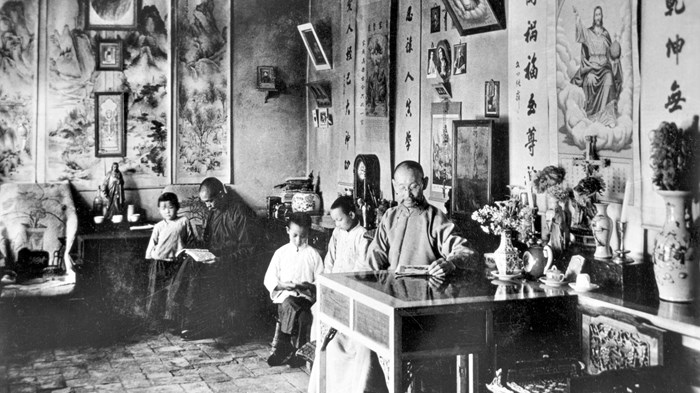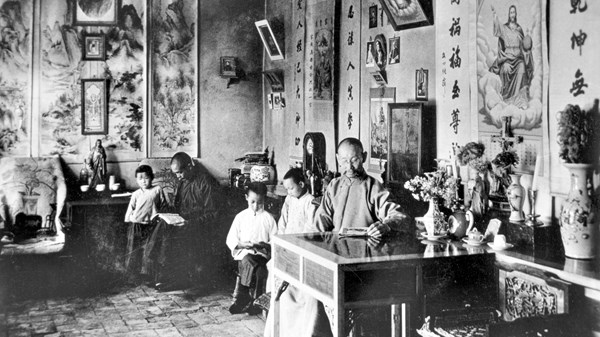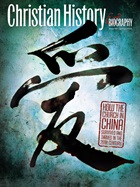
In the first half of the 20th century, the foreign missionary movement in China matured, flourished, and then died. In these same decades, a Chinese church was born—a church that is today growing incredibly rapidly. From 1900 to 1950, Christianity in China forsook its foreign origins and put on Chinese dress. The turbulent forces of history, which shaped all aspects of China's politics, economy, and culture, also burst upon foreign missionaries and Chinese Christians.
If we take a historical telescope and focus just on two years, 1932-1934, we can see the transformation of Christianity in China in mid-stream. And it began with a transformation of the missionary endeavor itself.
On an autumn day in 1932, Pearl Buck, born in China of missionary parents and herself a famous missionary there, strode to the podium in the ballroom of New York City's Hotel Astor to address 2,000 Presbyterian women. Buck had just received the Pulitzer Prize for her novel The Good Earth. Now she addressed the topic "Is There a Case for Foreign Missions?" Her answer was technically "yes," but it was so qualified and unenthusiastic, and her criticisms of missionaries for being arrogant, ignorant, and narrow-minded were so trenchant, that she left her audience stunned. This event ignited a firestorm of agitated comment by both critics and defenders of foreign missions in almost all quarters of American Protestantism. It was a sign of the times.
Another sign of the times was the publication of Rethinking Missions: A Laymen's Inquiry After One Hundred Years, commissioned by John D. Rockefeller Jr., the foremost individual financial supporter of missions in the U.S. Widely circulated and read, the Laymen's Report advocated an overhaul of missionary thinking, especially on such questions as the exclusivity of Christianity.
Also in 1932-33, Robert Service, the former UC-Berkeley track star who had pioneered the establishment of YMCAs in western China, was unexpectedly sacked. In the midst of the Great Depression and dwindling contributions, the YMCA and other well-established missions in China had a massive financial crunch in the early 1930s. Their expensive institution-heavy facilities, especially hospitals, schools, and colleges, swamped the mission budgets. Many missionaries headed home.
The missions movement was clearly on the defensive.
Hopeful Signs
Despite these negative portents, however, there were still enthusiastic young people answering the "call" to China. The China Inland Mission (CIM), that remarkable multinational creation of J. Hudson Taylor's, continued the dramatic growth it had enjoyed since the late 1800s. Its "faith mission" principles (no denominational or other regular financial support) managed to adapt to the new climate of scarcity.
Even as other missions were shrinking because of discouragement or shrinking budgets, the CIM launched a successful campaign to add 200 missionaries. David Adeney, a young Cambridge University student, learned of this campaign for "the 200" and felt a strong call to China. He came to north central China in 1934 and found his niche working with students, which he did until he left in 1950. He established ties which remained intact though dormant for more than 30 years, and which were renewed in heartwarming fashion when Adeney returned to China in the 1980s.
In addition to signs of life in theologically conservative missions like CIM, a wave of Pentecostal revivalism was sweeping through some parts of China. A traveling Norwegian evangelist, Marie Monsen, was the catalyst for the famous "Shantung Revival." Participants saw tongues of fire and heard roaring winds, and some even fell to the ground half-conscious. Pentecostalism, with its stress on the "gifts of the spirit," including prophecy, divine healing, and speaking in tongues, also fed the growth of most of the independent churches that had begun organizing by the 1920s.
In these years it could be dangerous to be a Christian in China, whether foreign or Chinese. A few months after David Adeney's arrival in 1934, one of the most dramatic incidents of martyrdom in China missions history occurred. John and Betty Stam, an attractive young couple who were products of Moody Bible Institute in Chicago and had come to China with the CIM a couple of years before, were stationed in a small city in Anhui province (central China). When Communist troops captured the city in late 1934, they beheaded the Stams and killed some local Christians who pleaded for the foreigners' lives, but the Stams' three-month-old child was safely taken to a nearby mission station. This story gained much publicity and motivated many young people to go to the mission field.
The effect was much the same as what happened after the death of Yale graduate Horace Pitkin in the Boxer Uprising of 1900. Pitkin died along with more than 10 other foreign missionaries—Presbyterian, Congregational, and CIM—in Baoding, not far from Beijing. His death spurred a surge in mission applicants, many from East Coast colleges, and the establishment of the Yale China Mission in the early 1900s.
The End of the Golden Age
The Boxer Uprising had begun as a peasant rebellion against the increasing commercial, political, and religious encroachment on Chinese culture by Western nations. The Boxers killed hundreds of foreigners, including about 250 missionaries and missionary children, as well as 20,000 or more Chinese Christians (who were considered traitors). In retribution, the occupying troops of eight nations killed at least that many other Chinese in 1900-1902. It was a disaster for China. Yet paradoxically, this national trauma triggered a national reform movement. For a short time, the xenophobia of the past was discredited and China was more open to the West. (Later, the Communists would praise the Boxers as patriots.)
This gave Christian missions in China the largest opportunity they had ever had—truly a "Golden Age." Mission schools suddenly had high prestige and waiting lists. Members of the elite class became Christians. Rates of growth skyrocketed, especially for Protestants. After the revolution which overthrew the feeble Manchu dynasty in 1911-1912, the provisional president of the young Republic was Sun Yat-sen, a baptized Christian. In 1913, the Republic's second president asked the foreign missionary community in China to pray for the nation. Protestant missionary numbers soared from more than 1,300 in 1905 to 8,000 in 1925. Many Christians were confident that events were moving inexorably towards the "Christianization" of China.
It was not to be. The Golden Age lasted less than two decades, until the mid-1920s. What went wrong? During that time, practically all missions in China failed to sufficiently cultivate a Chinese leadership in their mission structures and to permit that leadership to shepherd the flock into independent and self-supporting local churches. The rhetoric of moving from (foreign) mission to (Chinese) church was always present, but it was mainly hollow. At times it appeared that the foreign mission establishment had given way to Chinese leadership. The national missionary conference of 1907 had only half a dozen Chinese delegates out of more than a thousand; the next major conference in 1924 was called the "Christian" (not "missionary") conference, and more than half the delegates were Chinese.
But looks were misleading. It was at best a partnership, and an imbalanced one at that. In almost all cases, missionaries still controlled the purse-strings. The result was that the best Chinese leaders nurtured by the Protestants—such as Cheng Jingyi, respected head of the Church of Christ in China, and Yu Richang (David Z. T. Yui), gifted national secretary of the YMCA—never shed the image of being subordinate to foreign missionaries.
The Protestants put Chinese in leadership roles where they at least had the appearance of responsibility and power, even if that power was limited by close association with foreign missions. The Roman Catholic Church in China suffered even more from tokenism. The Catholic hierarchies in China had for decades permitted (and closely supervised) the training of Chinese priests, who were given mundane tasks and little responsibility. But no Chinese bishops were consecrated until 1926, after a couple of maverick European missionary priests, in particular Fr. Vincent Lebbe, convinced the pope to break the stranglehold that the European hierarchy had over the Chinese clergy. Even so, Chinese priests still continued to be largely relegated to secondary roles in the local parishes, and the new Chinese bishops were shunted into subsidiary functions.
Tainted by Association
There was almost certainly no conscious conspiracy among foreign missionaries to deprive Chinese leaders of the means of emerging and flourishing. There was often respect, genuine friendship, and collegial cooperation between missionaries and Chinese priests and pastors. But in the new political atmosphere that was brewing after 1920 in China, such ties were fatally compromising to the Chinese involved.
In the 1920s, popular resentment against foreigners' legal privileges in China, which dated back to treaties signed by the Manchu government in the mid-1800s, boiled over. This popular nationalism fueled the rapid rise of two major political parties that have dominated Chinese politics from the 1920s to the present: the Kuomintang (the Nationalists) and the Communists, which became bitter rivals and then mortal enemies. The leader of the Nationalists was Chiang Kai-shek, himself a Christian convert and married to Soong Mei-ling, the daughter of one of China's most prominent Christian families. Under Chiang, there were several other Christians in government positions and polite, even cordial relations with the foreign mission establishment. But even Chiang agreed that foreign privileges should be eliminated as soon as possible, especially immunity from Chinese laws.
Missionaries were among those who enjoyed these privileges. There had been the occasional missionary prophet (for example, Frank Rawlinson, editor of the Shanghai missionary journal The Chinese Recorder) who warned that the seeds of the "treaty system," as it was called, might bring a harvest of wrath someday. That day arrived in the mid 1920s, and the most radical elements of Chinese opinion considered missionaries, and for that matter Chinese Christians as well, lackeys of foreign governments and of "world capitalist exploitation."
These attitudes, which pervaded the Communist Party, continued strong until the last foreign missionaries were expelled from China in 1951-1952 by the new government. The missionary community, and the mission project as a whole, paid a high price for its failure to distance itself from at least some aspects of Western political, military, and economic power in China.
This portrayal of the missionary record may seem unfair to some. Missions had brought many blessings to China. Chinese Christian schools had been the first places where Chinese could receive a modern education, and the first to permit enrollment of girls and to employ women teachers. Missionary hospitals and clinics had saved tens of thousands of lives, and missionary-coordinated famine relief saved hundreds of thousands, if not millions. Missionaries had been leaders in the movements to abolish the opium trade and to end the custom of binding and crippling the feet of young girls as a means of increasing their desirability for marriage.
All in all, the missionaries' contribution to the making of modern China was considerable. Though they were reviled and demonized by the new regime after 1949, they are quietly given credit for their accomplishments and warmly welcomed back to visit China today.
Homegrown Faith
If missions were anathema to many Chinese, and many Chinese Christians were tainted by their identification with foreign missionaries, how did Christianity enter the Communist period with enough resilience to survive the dark valley of 30 years and to flourish since 1980?
After Japan went to war with China in 1937, most missionaries left, but hundreds stayed in "Free China," beyond Japanese reach, and ministered during the Pacific War. About 1000 others were interned in camps by the Japanese, where many died, including Eric Liddell of Chariots of Fire fame. Chinese Christians who remained under Japanese rule now suddenly had full responsibility for their churches and fellowships, and many rose to the challenge, developing leadership skills that were later useful under Communism.
In the brief period between the Japanese surrender in August 1945 and the Communist victory in 1949, a few thousand missionaries returned (including David Adeney). By this time the hated treaties were gone, and foreigners were under Chinese law. But after the Communists took the upper hand in the civil war and established their new government, they decided in 1951, in the context of the Korean War, to expel all foreign missionaries. Dramatic stories abound about the extrication of the last missionaries from the remote hinterlands of China.
Thus ended the foreign missions movement in China, but not the Christian movement. From the 1920s on, there had been another, very healthy development: the growth of independent, wholly Chinese-led movements that had roots deep enough for believers to hold fast when the storms came. By 1949, it is likely that 25% of Chinese Protestants were in these independent churches. They constitute a surprisingly little-known story, with some fascinating personalities.
The fiery evangelist John Sung traveled the country and drew huge crowds. Fundamentalist pastor Wang Mingdao (who would have a fateful clash with the new regime in the 1950s) built his own "tabernacle" for services in Beijing in addition to speaking all over China. Watchman Nee was working out his Holy-Spirit-centered theology. Paul Wei, a Beijing cloth dealer, founded the True Jesus Church, which grew explosively. Jing Dianying developed and ruled rural Christian communities of the "Jesus Family," based on the principles of common ownership and group-directed life. There were important female leaders as well, including Mary Stone. Her Bethel Seminary in Shanghai produced the "Bethel Band" of zealous young musician-evangelists, who spread revival all over China.
Resilient groups of believers carried on, both in the missionary-related and the independent churches. The missionaries were flawed but sincere sowers of the seed; it was left to the Chinese Christians to take their faith into the last half of the 20th century and reap a bountiful harvest in the 1980s and beyond.
Daniel Bays is professor of history and director of the Asian studies program at Calvin College.
A Gallery of Missionaries
Lemuel Nelson Bell (1894-1973). L. Nelson Bell and his wife Virginia were medical missionaries for the Southern Presbyterian Church. They served at the Love and Mercy Hospital in Qingjiangpu, in the province of Jiangsu, for 25 years before finally returning the U.S. in 1941 during the Japanese occupation. Their daughter Ruth (far right), the future Mrs. Billy Graham, was born in China. In 1956, Bell and Graham co-founded Christianity Today magazine.
Minnie Vautrin (1886-1941). As a teacher at the Ginling (Jinling) College in Nanjing, American missionary Wilhelmina (Minnie) Vautrin was in the city when the Japanese army invaded and the horrific "Rape of Nanking" occurred. Rather than fleeing, Minnie stayed and turned the college into an asylum for thousands of women and children, saving many lives. But the memory of the looting, burning, raping, and killing she had witnessed haunted her. She later had a nervous breakdown, was hospitalized in the U.S, and took her own life.
Frédéric-Vincent Lebbe (1877-1940). Born in Belgium, Catholic missionary Vincent Lebbe became a Chinese citizen because he believed that missionaries should identify as closely as possible with the Chinese people. He strongly advocated the consecration of Chinese bishops, and his influence eventually led to this ideal becoming a reality. He was taken captive by the Communists in 1940 and died soon after.
John and Betty Stam (1906/07-1934). One of the most dramatic missionary martyr stories of 20th-century China was the public beheading of the Stams, a young CIM couple who had graduated from Moody Bible Institute, by Communist soldiers in 1934. Their baby daughter Helen was hidden in blankets and rescued by Chinese Christians. The courage of the Stams inspired many others to become missionaries.
Eric Liddell (1902-1945). Olympic-gold-medal winner Eric Liddell, celebrated in the movie Chariots of Fire, ran a much harder race than most people know about. After the Olympics, he moved to China, where his family were missionaries. During the Japanese invasion, all foreigners were interned in prison camps. Eric was a beloved spiritual leader and friend in his camp, showing special concern for the young people. He died of a brain tumor only months before the camp was liberated.
Jonathan Goforth (1859-1936). After barely escaping from the Boxer Uprising, Canadian missionaries Jonathan and Rosalind Goforth returned to China in 1901. Jonathan prayed that God would bring revival to China as he had in Korea, and in 1908 Jonathan witnessed such a revival while preaching in Manchuria. For the next three decades, he became one of the most widely known itinerant evangelists in China.
The Billy Graham of China
John Sung (1901-1944)
Though his ministry lasted only a dozen years, John Sung blazed a flaming trail of revival across China and most of Southeast Asia. Born the son of a pastor in southern China in 1901, he was sent by his family to the United States for theological study. Instead, he enrolled in a university and went on to earn a Ph.D. in chemistry. A guilty conscience then led him to Union Theological Seminary in New York, where he was converted after hearing a young evangelist whom his fellow students mocked as too simplistic.
As a fresh convert, Sung was so zealous that the seminary president had him committed to an insane asylum. For the next 193 days, he read the Bible 40 times. On his way back to China, he threw almost all his diplomas overboard (except the Ph.D. to show his father) and dedicated himself to full-time evangelistic work.
From 1928 to 1940, Sung traveled all over China and also Singapore, Indonesia, Malaysia, the Philippines, Taiwan, and Thailand. He preached to large crowds, some of whom walked long distances in bad weather to hear him. A painful physical ailment sometimes forced him to preach sitting or even lying down. Tens—perhaps hundreds—of thousands were converted through his ministry. He never emphasized miracles, but countless people were healed through his prayers after he had preached.
Despite multiple threats on his life, narrow escapes from death, and repeated warnings from powerful people, Sung fearlessly denounced sin and called for total faith in Christ and radical obedience to the Great Commission. Especially in his early years, he often exposed the faults of church leaders publicly; some hated him for it, but many more humbled themselves and changed their lives.
He organized evangelistic teams wherever he went. Those who were moved by his example and teaching formed several Bible schools. He knew that he must strengthen the Chinese church: "One day the Western funds will stop coming, then the churches will be in a dilemma. But only then will the churches in China have revival."
His recently discovered and translated diaries reveal John Sung to be a man of tender conscience, constant self-examination, daily repentance, and unremitting pursuit of holiness. In the end, his constant travel and preaching took its toll, and he was forced to rest for the last three years of his short life. But during that time he became even more convinced of certain spiritual truths: "For a servant of God to have authority in every sentence he utters, he must first suffer for the message he is to deliver. Without great tribulation, there is no great illumination."
—G. Wright Doyle, director of the Global China Center and the China Institute
Everything for the Lord
Watchman Nee (1901-1972)
"I want nothing for myself," said Watchman Nee, "I want everything for the Lord." These words summed up the life of one of the most important Chinese church leaders, evangelists, writers, and martyrs of the last century.
Nee's grandfather was a Congregational minister. His mother had been brought up Methodist. He received a Western education in missionary schools and was converted by the powerful preaching of evangelist Dora Yu. Although he was grateful to the missionaries for bringing the gospel to China, Nee was also critical of them and of the state of the Chinese church. He spoke against the church's superficiality and the inability of some ministers to lead their converts on to spiritual maturity.
Nee formed an independent Christian assembly in Fuzhou in 1922. It practiced believer's baptism and a weekly Lord's Supper, and was governed by elders rather than by a single pastor. Nee believed from his reading of the Book of Acts that such an assembly should be the only church in a particular locality. In 1928, he moved his base from Fuzhou to Shanghai, where outsiders nicknamed his group the "Little Flock Church." His followers formed new evangelistic groups, launching a nationwide movement.
The revival sparked by the Little Flock helped rouse the denominational churches from their complacency and energize them to meet the deeper spiritual needs of the people. Nee emphasized "the priesthood of all believers" and urged the Chinese churches to train their own leadership, develop their own forms of ministry, stop being dependent on foreign financial support, and spread the gospel. These principles prepared Chinese Christians for the terrible conditions they would face under Communism. By 1950, the Little Flock had 70,000 members in 700 assemblies.
Nee became an eloquent, widely-known evangelist and writer who had a gift for calling people to a deeper spiritual life. He believed that a human being is composed of a body, a soul (intellect and emotions), and a spirit (which communes with God), and his teaching stressed the need for spiritual regeneration and sanctification in order to understand Scripture rightly and live in step with the Holy Spirit. His sermons and books—the best known of which is The Normal Christian Life—continue to be republished in a number of languages and are read all over the world.
In 1956, Nee was publicly tried, condemned as the head of a "counter-revolutionary clique," and sentenced to 15 years in prison. He died in May 1972 at a labor camp in the Anhui province. Today, the Little Flock is the largest Christian group in China and has an international following.
—Yading Li, senior associate of the Global China Center
Copyright © 2008 by the author or Christianity Today/Christian History & Biography magazine.
Click here for reprint information on Christian History & Biography.

Support Our Work
Subscribe to CT for less than $4.25/month






























